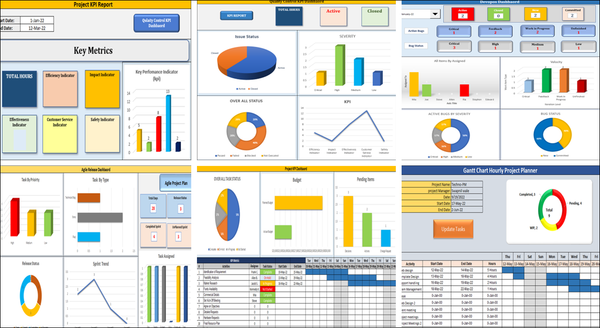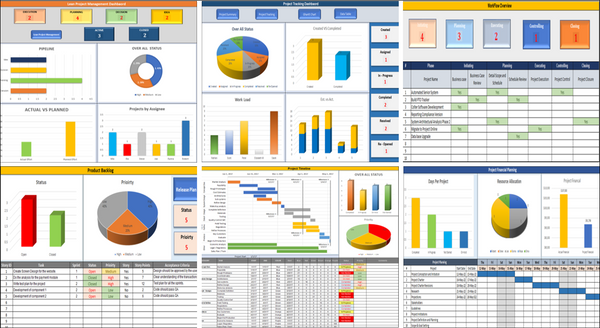A Guide to MS Excel for Project Management
Project management is the process of creating and monitoring processes successfully. Every enterprise works on multiple operations simultaneously, and project management ensures the projects are effective, organised, and ready for execution. MS Excel for Project Management is one of the most popular software programs for planning projects. Regardless of the organisation, size, industry, or age, people use MS Excel to control and manage various projects across multiple platforms and track their progress.

Excel for Project Management
Project managers use MS Excel to manage simple projects and improve and fasten the planning and monitoring stages. They usually implement Excel to work on small or mid-sized operations to increase efficiency. Microsoft Excel assists project managers in preparing every step of project management using organised spreadsheets containing separate columns to enter and track tasks, assigned teams, and the project timetable.
Companies use Excel spreadsheets to record their progress, document confidential data, and manage project and business finances. Excel might not cover all project management components, but it offers the necessary resources to equip organisations with the proper tools to finish projects successfully. Excel delivers management assistance cost-effectively and efficiently, saving organisations time and money. MS Excel provides enterprises with various features, such as:
- Data Modification: Projects contain multiple data sets, making changing or browsing through them challenging. Excel allows project managers to sift through data sets conveniently, search for the relevant data, and alter it accordingly.
- Analytical Resources: Excel's analytical tools help experts assess and monitor large chunks of data and organise them visually using charts and spreadsheets.
- Track Project Status: Using MS Excel, organisations can record project timetables and duration to ensure each task runs smoothly and according to the proposed plan.
- Identify Gaps: Microsoft Excel helps project managers obtain and analyse data to identify application vulnerabilities. Spotting gaps allows managers to eliminate them early, prevent future errors, and close tasks safely.
When is Excel the Best Choice?
Excel works best and is an excellent choice if the project is small or mid-sized, the project management team is small, and you want to achieve successful results quickly and efficiently. Opt for MS Excel if your project checks one or all the following factors:
- Individual Work or a Small Team: Excel is the best choice for small project teams or people working solo. Instead of relying on a complex platform, you can use Excel's easy-to-navigate layout and features to wrap up your task.
- Simple and Easy: As a simple and effective platform, Excel allows users to organise their tasks, track their progress, and modify operations easily and automatically without any manual assistance.
- Cost-Efficiency: MS Excel comes in handy when you require efficient and cost-friendly management software to work on small and one-person projects.
When Should You Use Excel for Project Management?
Rather than investing time and money in purchasing and learning how to use complex project management tools, Excel's easy-to-use spreadsheet offers versatility and adaptability. Excel is the best software to use if:
- You are Assigned a Simple Task: You don't necessarily require fancy management tools if your project involves a few components and a small team. Excel's simple interface and spreadsheet allow you to enter project tasks and control them seamlessly.
- Singular Projects: Singular projects require a specific number of resources and tools. Unlike multiple projects requiring an entire team, elaborate tools, and shared resources, single projects work best with Excel spreadsheets.
- You Have Microsoft Office: Microsoft Office is one of the most popular client software, and since MS Excel is a part of the Microsoft software family, you can easily manage and work on your projects as long as you have MS Office.

Disadvantages of Managing Projects in Excel
Every software management platform has its advantages and disadvantages; Excel is not an exception to the case. MS Excel for Project Management offers multiple benefits. However, in case of large-scale and complicated projects, MS Excel falls a little short in some cases, such as:
- Sharing and Collaborating: Managing multiple projects and tasks using Excel is challenging, as its simple layout makes it difficult for different teams to work together. Collaborating requires various formulas, cells, and components that enable network sharing, which can be tricky in Excel.
- Third-Party Communication: MS Excel does not provide a platform to communicate within or with other teams. Project managers will need to schedule meetings through external applications like Zoom, Google Meet, and Microsoft Teams if a project requires collaboration.
- Harder to Track Data Modifications: Controlling and tracking file edits and versions is tricky in Microsoft Excel. When various teams or people are working on the same project, the data file will undergo multiple and overlapping revisions, making it challenging to monitor additions or removals. Preserving data modifications would require the project team to use codes and complex elements.
Excel Project Management Use Cases
A significant difference between Microsoft Excel and other management software is that while other tools were explicitly made for project management, project management is not Excel's primary function, even though it handles project planning efficiently and effectively. It can control project tasks, such as financial management and organization. MS Excel offers templates to help in project planning like:
- Timeline Chart: Microsoft Excel allows users to design timeline maps, build project schedules, and control each project stage. The timeline feature includes horizontal spaces to enter tasks, placed next to each other to form an organized project visual and schedule.
- Financial Assistance: Excel is a master at mathematical-related functions, and financial matters require exceptional mathematical prowess. Excel helps users create and manage a budgetary report, including detailed and complex data, to track the finances of small or mid-sized projects.
- Task List: Task lists enable project managers to design checklists and tasks to organize daily schedules and routines. A checklist allows teams to monitor their status, check available resources, and ensure team members are finishing their operations on time.
- Reviewing Projects: Excel lets you acquire and manage data to generate an extensive and accurate personalized report. The software's analysis and mathematical tools create documents according to the documented inputs and business needs.
Best Project Management Templates & Spreadsheets for Excel
Microsoft Excel provides some of the most advanced templates and spreadsheets for project planning and management, including:
- Gantt Chart Template
- Project Status Report Template
- Work Breakdown Structure Template
- Action Plan Template
- Project Tracker & Task List Template
- Risk Register Template
- Issue Tracker Template
- Change Request Form Template
In Conclusion
MS Excel for Project Management offers enterprises and project teams a simple and effective method of planning projects. It is an efficient tool best suited for and compatible with small and mid-sized tasks and enhances data organization cost-effectively and safely.



